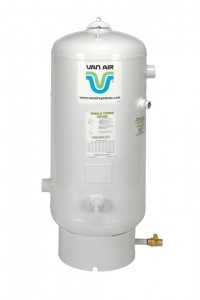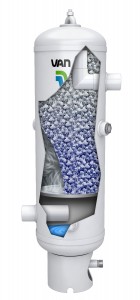What is a Deliquescent Dryer and what makes it different from refrigerated or regenerative dryers?
There is often confusion in the compressed air industry, when differentiating various forms of moisture removal equipment from compressed air systems. The confusion of which type of compressed air dryer to select in various situations can be daunting yet can be explained by further explaining how each dryer works. A brief description of each of the dryers available may simplify understanding.
What Are Deliquescent Dryers?
Deliquescent dryer technology was developed in 1945 by Van Air Systems and has since been successfully applied to demanding environments worldwide. Single Tower, Deli, and Freedom Dryer, are just a few of the terms used to describe a Deliquescent dryer.
Van Air Systems and has since been successfully applied to demanding environments worldwide. Single Tower, Deli, and Freedom Dryer, are just a few of the terms used to describe a Deliquescent dryer.
“Simplicity” is an appropriate descriptive term for Deliquescent technology. When observing this system in the field, one will initially see a trim cooler, which removes the heat of compression produced by the compressor. Following the cooler, a prefilter removes oil vapor and particulate.
The compressed air then enters the bottom of the dryer. Compressed air travels slowly, (12’ per minute) through the dryer’s bed of Dry-O-Lite (DOL) desiccant contained within. These tablets are manufactured in Lake City, PA, exclusively by Van Air Systems. Dry-O-Lite tablets are sodium chloride based and react with the moisture rich compressed air.
As the air travels through the dryer, the tablets remove moisture from the compressed air while dissolving into an environmentally safe brine solution. This moisture falls to the bottom of the dryer and is drained at regular intervals. After the treated air exits the top of the dryer it passes through a particulate filter and travels downstream to be used in operation.
Maintenance is simple. Check the dryer’s sight window periodically to ensure its filled with Dry-O-Lite and drain the vessel at regular intervals (once per 8-hour shift). Deliquescent dryers, filled with Dry-O-Lite offer a 20°F dew point suppression, based on their incoming air temperature.
Example: Incoming air temperature to the dryer dictates the exiting dew point reading. Pressure Dew Points (PDPs) fluctuate up or down, depending on incoming air temperature.
- An incoming compressed air temperature of 50°F/10°c can expect to achieve an outlet PDP of 30°F/-1°c.
- An incoming air temperature of 40°F/4.4°c can expect to result in an outcoming PDP of 20°F/-6.6°c. In this example, if downstream air-lines don’t witness atmospheric temperatures lower than 20°F, no condensate will form inside the compressed lines or in processes.
 Deliquescent dryer systems can be placed indoors or outdoors. In fact, it is favorable to place them outdoors to take advantage of atmospheric cooling. As a rule, Deliquescent dryers should be placed where the coolest temperatures are available and where line pressure is highest. Condensation protection of air lines can be achieved at temperatures down to 0°F/-17.7°c with Dry-O-Lite tablets. A more aggressive desiccant, known as 10BF, is capable of a 63°F dew point suppression and is used in environments that experience extreme winter temperatures. While 10BF is costlier than Dry-O-Lite, Van Air offers systems that incorporate both Dry-O-Lite and 10BF, in simultaneously staged vessels. Less costly Dry-O-Lite desiccant, stored in an initial vessel, provides sacrificial support for a second vessel, filled with the costlier 10BF. These uniquely tailored systems have been field tested to provide PDPs’ in subzero temperatures and have proven to vastly outperform refrigerated dryers in very extreme environments.
Deliquescent dryer systems can be placed indoors or outdoors. In fact, it is favorable to place them outdoors to take advantage of atmospheric cooling. As a rule, Deliquescent dryers should be placed where the coolest temperatures are available and where line pressure is highest. Condensation protection of air lines can be achieved at temperatures down to 0°F/-17.7°c with Dry-O-Lite tablets. A more aggressive desiccant, known as 10BF, is capable of a 63°F dew point suppression and is used in environments that experience extreme winter temperatures. While 10BF is costlier than Dry-O-Lite, Van Air offers systems that incorporate both Dry-O-Lite and 10BF, in simultaneously staged vessels. Less costly Dry-O-Lite desiccant, stored in an initial vessel, provides sacrificial support for a second vessel, filled with the costlier 10BF. These uniquely tailored systems have been field tested to provide PDPs’ in subzero temperatures and have proven to vastly outperform refrigerated dryers in very extreme environments.
Deliquescent dryers are protected with a 10-year pro-rated warranty. This life span exceeds any form of compressed air dryer option on the market. The fact that no electricity is required to operate, and that they require no purge loss, makes Deliquescent dryers the most economical option, based on their flexible nature and ability. Deliquescent dryers are a preferred option for troublesome environments such as ready mix/asphalt plants, lumber yards, feed mills, remote locations and almost any industrial setting not requiring instrument air.
For more information on Van Air Systems Desiccant Compressed Air Dryers, or to help select a compressed air dryer suitable for your application, please call us at 1-800-840-9906.
Refrigerated Dryers
Cooling down compressed air is the basic premise of a refrigerated air dryer. Hot, fully saturated air leaves the compressor and enters the refrigerated dryer. This equipment uses a refrigerant, that passes through a continuous loop system within the dryer and is indirectly exposed to the hot wet compressed air.
Using electricity and many internal components, these dryers take compressed air dew points down to roughly 39°F/4°c when they are brand new. If downstream air lines don’t experience atmospheric temperatures lower than 39°F, condensation should not form inside these air lines.
The ability to hold dew points at stated levels, decrease over the lifespan of these dryers, and typically climb into the 40s and 50s (F) as the dryer ages. The caution of refrigerated dryers is that they are often misapplied and installed in areas exposed to atmospheric environments that will experience freezing temperatures. These dryers should be used for indoor applications, in northern environments.
Example: A refrigerated dryer, installed in a North Dakota ready mix plant, exposed to sub-zero winter temperatures can be a recipe for freeze ups and costly down time. While the refrigerated system may have been the least expensive choice up front, it can prove to be a very costly misapplication in the long run. A brand new refrigerated dryer can expect to operate a few years prior to some form of necessary maintenance. The life span of these dryers is very dependent on where they are installed and how they are maintained.
A neglected system, installed outdoors in a rugged environment such as our ready-mix plant, can expect to ingest cement dust and will most likely overheat due to the dust accumulating on the heat exchanger. If this same dryer experiences winter temperatures lower than 39°F you can also expect to see lines that will ice and there will undoubtedly be down time. A typical warranty for a refrigerated dryer runs roughly 12 months.
Regenerative Dryers
 Dual Tower, Desiccant, Pressure Swing, Instrument air, Heatless/Heated Regen. These are some descriptions of a Regenerative Air Dryer. “Instrument quality air dryer” may be the most appropriate description of this system, in that its product is suitable for consumption in applications where the term “Instrument quality” is a requirement by the consumer or process. This translates into a -40°F/-40°C, and in some cases -100°F/-73°C dew point.
Dual Tower, Desiccant, Pressure Swing, Instrument air, Heatless/Heated Regen. These are some descriptions of a Regenerative Air Dryer. “Instrument quality air dryer” may be the most appropriate description of this system, in that its product is suitable for consumption in applications where the term “Instrument quality” is a requirement by the consumer or process. This translates into a -40°F/-40°C, and in some cases -100°F/-73°C dew point.
These systems virtually insure that downstream compressed air lines are protected from moisture condensation and freeze ups. These systems hold adequate dew points given the desiccant inside the two towers are protected from contamination. They are also dependent on appropriate trim cooling and rigorous filtration.
The two towers are filled with desiccants known as Activated Alumina or Molecular Sieve. These desiccants are very effective in attracting and holding the moisture as the fully saturated air passes through them. In operation, one tower is drying the incoming compressed air while diverting a large percentage of the super dry air and purging the moisture from the other tower. The towers switch their roles constantly and therefore the term “regeneration” is appropriate for this system.
Purge loss of compressed air can be very costly over the life of the regenerative dryer, because as much as 15-19% of your compressed air will be consumed by this mandatory process. Should Alumina or Molecular Sieve be contaminated by oil or dirt, these systems rapidly lose their stated dew point capabilities. This is a result of the tiny pores in the desiccant being clogged and failing to hold moisture effectively. Therefore, the saturated compressed air simply travels downstream, past filtration, and condensates in airlines and processes. All the while, the dryer still requires costly purging.
Another caution is improper cooling of incoming air to these dryers. Compressed air exposed to the desiccant over 100°F/38°c, will harm the desiccant and most likely destroy its ability to perform. With proper filtration and cooling, the desiccant in these dryers can expect to maintain required dew points for 3 to 5 years. Regular sampling of the desiccant can reveal the quality of the desiccant and indicate when replacement is needed.
After a few years of constant use, these dryer systems will most likely require a laundry list of repairs, including valve rebuilds, control box repairs and a variety of other issues. Again, the performance of these dryers depends on the maintenance and environment in which they are installed. Regenerative systems do not like dusty dirty environments and should be protected from adverse environmental factors.
Example: A regenerative system typically requires at least 40°F/4.5°c temperatures to operate. Installing one of these dryers in an outdoor ready-mix plant, feed mill, lumber yard or any other environment where it is exposed to extreme temperatures may result in eventual down time. A typical manufactures warranty runs for 12 months for these systems.
Read more about our regenerative air dryers.
